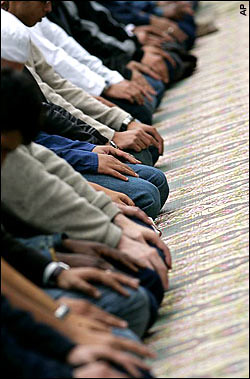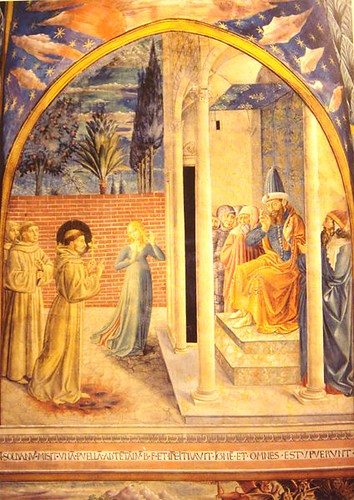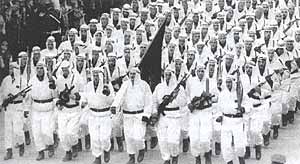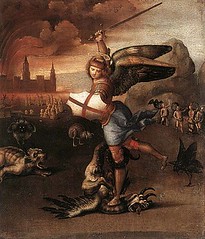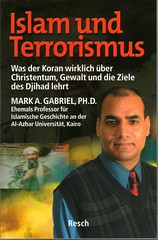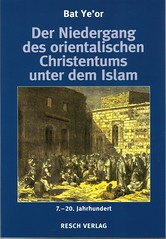Forging a Unique Spanish Christian Identity:
Santiago and El Cid in the Reconquistaby Laura Elizabeth Gibbs
St. James the Moorslayer, one of the most valiant saints and knights the world ever had … has been given by God to Spain for its patron and protection. — Cervantes, Don Quixote (1)
This is the will of God and of all His saints. … You see the sword bloody and the horse sweating: Thus it is that one [El Cid] conquers the Moors in the field. — Poema de mío Cid (2)
In 711, Muslim armies from North Africa crossed the Straits of Gibraltar and entered the southern region of Spain. During the next seven years, the Muslims conquered the weak kingdom of the Visigoths and firmly established themselves on the Iberian peninsula. They called their territory al-Andalus or "Vandal land". Christian resistance to Muslim advances began almost immediately. However, the notion of a Christian holy war designed to exterminate or at least to expel the Muslims, and not simply to reconquer Spanish Christian territories, did not set in until the eleventh century during the reign of Alfonso VI (1085-1109). In this era of crusading reconquest, a need arose for the living presence of religious-national figures, capable of rallying around themselves the Spanish Christian forces. (3) Two figures emerged as emblems of Christian strength and supremacy: El Cid and Santiago. They fulfilled the needs of the Iberian Christians for heroes to emulate, and united them in their struggle for political and religious independence from Muslim rule. As Christian paragons, Santiago and El Cid became increasingly identified with one another. Christians attributed identical symbols to them, and their images merged to the point of indistinguishability in the artistic depictions of these historical individuals in the eleventh through thirteenth centuries. The unification of the spiritual and the secular, symbolized by the convergence of these figures’ images, marked the birth of the formation of a united Spanish Christian kingdom, and the creation of a unique national-religious identity in Spain.
Under the leadership of Alfonso VI a decisive program of crusading reconquest began. The monarch’s objective entailed uniting all of Spain under one crown and one religion. Tolerance and coexistence with the Muslims were no longer options if Alfonso sought to create a truly unified Spanish Christian kingdom. Thus, Santiago and El Cid grew to immense national and religious proportions because both fulfilled an historical need. Santiago represented the spiritual component of Alfonso’s agenda. The Leonese monarch called upon Spaniards to fight against the Muslims and establish the supremacy of the Catholic church. To ensure the success of the reconquest, Spaniards believed God sent his vassal Santiago to lead them in battle and help them realize their goal. El Cid represented the secular element of the Christian reconquista. As Alfonso’s vassal, El Cid united the Spaniards in their struggle to oust the infidels and reclaim the peninsula for the Spanish Christian monarch Alfonso and his peoples. The Christian reconquest created faith in Santiago and El Cid as leaders who inspired resistance to the Muslims, and promised ultimate victory over Islam. Despite the similarities these figures acquired in their roles as Spanish crusaders, their origins could not be more diverse.
Santiago or St. James was the son of Zebedee, a fisherman in Galilee, and Salome, the sister of the Virgin Mary. He and his brother John the Evangelist were devout disciples of Christ, and such zealous preachers of the good news that Christ named them Boanerges, "the brothers of thunder." In 44 A.D. Santiago became the first of the Twelve Apostles to suffer martyrdom when Herod Agrippa I arrested and beheaded him in Jerusalem. Tradition places Santiago in Spain proselytizing prior to his execution. Why then would his body be buried in Spain if he died in Jerusalem? According to legend, Santiago’s disciples Athanasius and Theodore took his body back to Spain when a ship miraculously appeared, guided by an angel, to transport them. They buried the saint in the area known today as Compostela, "field of stars," where Santiago lay forgotten for nearly eight centuries.
The rediscovery of the saint’s long-forgotten tomb in the ninth century occurred, tellingly enough, in a time of need "when Christian political fortunes in Spain were at there lowest ebb." (4) Christians suffered defeat time and again at the hands of the Muslims, until God unearthed the saint’s remains, and inspired them with the confidence that God was on their side, fighting in the battlefield with them through the figure of Santiago. "God gave us aid and we won the battle." (5) Christians endorsed the veracity of this claim by referring to the battle of Clavijo in 844. The night before the battle, Santiago appeared in a dream to the leader of the Spanish forces, King Ramirez of Castile, and promised him a victory over the Muslims in the fields of Clavijo. (6) The following day, as Christians fought the Muslims, the warrior-saint appeared on the battlefield in full armor riding on a white charger, with a sword in one hand and a banner in the other. Together with Santiago Matamoros, the Moorslayer, the Christians slaughtered the Muslim invaders and won a decisive victory. Undoubtedly, Santiago appeared in the battlefield at Clavijo for he left behind impressions of scallop shells (his symbol as the pilgrim saint) on the rocks in the field and even on the stones of neighboring houses. After this battle, Santiago’s name became the Christians’ battle cry, and his appearance in warfare the symbol of Christian victory.
According to legend, the saint aided the Spaniards at least forty times in earthly warfare, including the battle of Clavijo. This was a "brave assertion of faith in St. James, in the miracle at Clavijo, and in the patron saint’s heavenly care for Spain." (7) The Spaniards "needed Santiago as the supernatural ally who would sustain their courage and bring certain success to their arms." (8) This strong faith identified Santiago with the religious element of the reconquest and the revival of Spanish fortunes. It follows then, that at the end of the eleventh century when a decisively religious element entered the equation of the reconquista, an aggressive program of dignifying the apostolate of James and of exalting Compostela as the "second Rome" took place. (9) The image of Compostela as a "second Rome" points to the site’s religious significance, and established its importance as a preeminent place of pilgrimage. (10)
The successful ouster of the Muslims in 1492 was followed by skepticism regarding Santiago’s role in Spain’s holy war. Skeptics accepted Santiago as the patron saint of Spain, and even the possibility that he inspired Christians in warfare. But they flatly rejected the validity of the battle of Clavijo and the absurd notion of Santiago taking personal part in the conflict by slaughtering Muslims. In the eighteenth century,
Pope Benedict XIV rebuffed the unbelievers, and stated that Santiago’s Spanish mission was an historical fact and that there was no further doubt or debate on this subject in Rome. Speaking for all of Christendom, Pope Benedict declared Santiago’s participation and leadership as an essential and factual element of Spain’s Christian warfare against the Muslims — case closed. (11) The Pope’s declaration reaffirmed the tie between Spanish nationalism and Christianity established by Alfonso in the late eleventh century.
Santiago’s and El Cid’s fearless and victorious participation in the crusading reconquest acquired grandiose and mythical dimensions. Both became national-religious heroes during the reconquista, but El Cid was neither a disciple of Christ nor a saint. Nevertheless, in the minds of his followers he was the perfect secular counterpart to the ecclesiastical figure of Santiago. He was born in 1043 to a family of noble origins in the town of Vivar, and named Rodrigo Díaz. He acquired the Arabic honorific title sid meaning "lord," as well as the epithet Campeador, meaning "champion." While it is difficult to disentangle history from myth, there is little evidence to suggest that either of these were used by contemporaries as official titles when addressing El Cid. (12) It is probable that after his death in Valencia in 1099 the heroic exploits of El Cid were preserved, and magnified, in Spanish oral tradition. By the late twelfth and early thirteenth centuries, Rodrigo was no longer simply a gifted knight--he was the ever-victorious warrior lord, the Campeador El Cid.
The first documented use of the title "sid" appears in the epic Poema de mío Cid or Cantar de mío Cid. In this poem, composed in the Spanish vernacular in the early thirteenth century, "the hero is presented as a paragon, one whose lack of any self-destructive defect -- like the wrath of Achilles or the pride of Roland -- makes him the most perfect of all epic protagonists and the most successful." (13) El Cid represented the ideal Christian warrior, invincible in battle and flawless in character. The extraordinary image of El Cid developed in this epic prevailed over the less fantastic, but more realistic, image of the religiously indifferent, intelligent, successful medieval military strategist and warrior. Nevertheless, the legendary aspects of his character prevailed, serving as standards which Christians could follow on their path toward victory. This poem creates a window to the past into medieval Spain of the eleventh and twelfth centuries. It describes the hero in all his grandeur, and provides the context in which El Cid assumes his importance as the Campeador -- the unconquerable Christian warrior. In the legendary words of El Cid, "Thanks be to God Who is lord of the world/ I win battles, as pleases the Creator;/ Moors … go in fear of me." (14)
In 1072, El Cid became the vassal of Alfonso VI. To further secure his loyalty, in 1074 Alfonso arranged for El Cid to marry his niece Jimena Díaz. These were calculated efforts by Spain’s monarch to secure El Cid’s support for the national-religious warfare against the Muslims. Alfonso made careful attempts to thwart "any significant opportunity [on the part of El Cid] to exercise his military talents" without the king’s knowledge. (15) The king appears to have had a specific political-religious agenda, in which El Cid played an integral role.
During his reign, Alfonso "continued and extended the policy of alliance with the great French Benedictine monastery of Cluny, then achieving European prominence under Abbot Hugh the Great (1049-1109)." (16) By cooperating with the church and instituting Cluniac reform, Alfonso played a preeminent role in the Christianization of the reconquest. (17) His effort to create a unified Christian kingdom of Spain in the eleventh century sparked the need for religious and national figures under whom Christians could unite to defeat the infidel, satiated by the personages of El Cid and Santiago. People in Spain "were coming to believe that relations between Christians and Muslims were necessarily and justly hostile, that Christian warfare against Islam bestowed positive spiritual merit on the participant, and that the Muslims should be driven out of Spain." (18)
In accordance with his monarch’s wishes, El Cid participated in the unification of the religious and political spheres during the latter part of the eleventh century. One of the most important roles he played as a Christian war hero and patriot of the reconquest was the victory of his siege in Valencia and the Muslims defeat (1093-1094). (19) This triumph of Christianity was celebrated over a century later in the epic: "Great is the rejoicing in that place/ when My Cid took Valencia . . ./ My Cid rejoiced, and all who were with him,/ when his flag flew from the top of the Moorish palace." (20) In his role as a loyal Christian ruler El Cid converted Valencia’s Great Mosque into a Christian church, St. Mary’s Cathedral, in 1098. Furthermore, he proclaimed the Cluniac cleric Jerome of Périgord the bishop of Valencia. These acts indicated his solidarity with Alfonso and Cluniac reform, and his participation in the crusading mentality of the century.
An important manifestation of the crusading mentality during this time was the creation of an iconography of Santiago along national lines, using imagery rooted in the historical reality of the reconquest. As in the legend surrounding the battle of Clavijo, this iconography associated Santiago with the warfare against Islam; in it
Santiago is represented on a galloping [white] horse . . . sword in the right hand and the banner of victory in the left. Behind him the defeated infidels, crushed to the ground, helplessly moan; in front of him the powerless enemy surrenders . . . . Appropriately enough for the historical reality and the temper of the times, such an iconography of Santiago has received the designation of Matamoros . . . the slayer of the Moors. (21)
Through this iconography Santiago practically becomes El Cid: a folkloric figure riding upon a horse, leading the Christians to victory. The similarities in the depictions of these national religious heroes revolve around the use of four primary symbols: the sword, the banner of victory, the white horse, and the Muslims who lay dead at the feet of the victorious crusader. The banner of victory, like the horse, is usually white. This color symbolizes the spiritual purity of the Christians who will spill the red blood of the Muslim infidels. The most important of these symbols is the instrument of death, the sword, generally attributed to gods, heroes of unconquerable might, and Christian martyrs. It signifies military might, power, authority, and justice. (22) The Poema de mío Cid heavily emphasized the power of the sword, victoriously wielded by El Cid over the Muslims. For example, the epic describes the Almoravid leader Yusuf’s defeat at the hands of El Cid thus:
As pleased the Creator, they [the Christians] overcame them [the Muslims].
My Cid used his lance and then drew his sword;
he killed so many Moors that the count was lost;
above his elbow the blood ran.
…
My Cid was joyful, and all his vassals,
because God of His grace had given them triumph.
…
Thus he rode on Babieca, his sword in his hand. (23)
Using three of the four symbols, this excerpt indicates the Spaniards’ confidence that God empowered their national-religious heroes who ultimately led the Christians to victory. Once drawn, the sword of Santiago or El Cid, through the grace of God, became the tool by which Spain successfully expelled the Muslims, and completed its spiritual and secular union.
The development of a religiously and culturally homogenous Spanish kingdom, and the association of the images of Santiago and El Cid as paradigm Christian combatants continued throughout the remaining four centuries of religious reconquest. For Santiago, the process of intertwining his role as belligerent saint with crusading warfare culminated in 1170. In this year, the most famous Spanish military order, the Order of the Knights of Santiago, emerged, modeled upon the international order of the Knights of the Temple. (24) The Knights of Santiago was only one of several military-religious orders established to protect pilgrims on their journey to Compostela (the saint’s burial place), and most importantly, to fight against the Muslims. Like Santiago Matamoros, the knights "combined priestly devotion with soldierly blood-thirstiness. Their motto was Rubet ensis sanguine Arabum — ‘My sword is red with the blood of the Arabs’ — and their symbol was a sword-like cross with the scallop shell on the crosspiece." (25)
El Cid’s image as Christian and soldier evolved in a less militaristic and institutionalized manner. After his death in 1099, a "Cid-cult" grew up around his burial site in the monastery of San Pedro de Cardeña. In fact, many of the myths invented about El Cid and incorporated into history originated in Cardeña. The growth of the legend of El Cid occurred during a time when Christians were winning victories over Muslim forces in the East. The impact of the fall of Jerusalem in 1187 may have been felt in Spain, leading, for example, to a renewed interest in the paragon of Christian crusaders. By 1200, El Cid "had grown to uncommon heroic stature" outstripping even Spanish royalty as the subject of legendary interest. (26) This interest manifested itself in the composition of the epic Poema de mío Cid. In this poem, El Cid assumes Santiago’s role of Moorslayer and instills a combination of fear and admiration in both Christians and Muslims alike. His mission aimed at the complete reconquest of Muslim-Spain for Christianity; he would be satisfied with nothing less. As the Muslim Abengalbón laments in the epic, "In peace or in war he will have what is ours;/ who does not know the truth I hold stupid." (27)
The histories of Santiago and El Cid contain an inextricable mixture of historical fact and mythical legend. The legendary component fueled Spaniards’ faith in their ultimate victory over the Muslims. It gave them confidence when faced with an uncertain future. Thus, the mythical forces gave credence and urgency to the reality of divine intervention in Spain’s crusading reconquest. This intervention manifested itself in the forms of Santiago and El Cid — figures whose images over time intimately intertwined and became one. The resulting image was of a knight of uncommon heroic stature riding upon a white horse over a battlefield of slain Muslims, with a bloodied sword in one hand and the banner of victory waving in the other.
Spaniards believed God had brought Santiago from heaven to the battlefield and made El Cid invincible in war. Inspired by their heroes and inflamed by their passion for a united Spain under Christendom, Spanish Christians continued undeterred in their struggle against the infidel. Their struggles did not go unrewarded. When Pope Urban II called for the First Crusade in 1095, Spain had already experienced two significant victories against their Muslim opponents by retaking Toledo (1086) and Valencia (1094). The eleventh through the fourteenth centuries saw the gradual deterioration of Muslim power in Spain. By the twelfth century, the political-religious geography of the Iberian peninsula had changed radically from the tenth and eleventh centuries. In the fifteenth century Muslim rule in al-Andalus collapsed. The Muslim defeat in Spain was paralleled by an increase in the strength and power of the Christians. Guided by their religious national figures, Spaniards had succeeded in ousting the Muslims when they captured the city of Granada in 1492. The capture of Granada ended the chapter of Christian reconquest in Spain’s history, and ended Santiago’s and El Cid’s roles as inspirational leaders and invincible warriors in the eight centuries long reconquista. Spain succeeded in expelling the Muslim peoples and their religion, while simultaneously forging a new national Christian identity. The Iberian peninsula emerged from the Christian reconquest — as Alfonso VI intended it to be — unified under the Spanish monarchy of Isabela and Ferdinand and by its Christian faith.
Notes
1 Quoted in Ellen O. Feinberg, Following the Milky Way: A Pilgrimage Across Spain (Ames, Iowa, 1989) 82.
2 Poema de mío Cid, Canto 95, trans. W. S. Merwin, Medieval Epics (New York, 1959) 528.
3 William Melczer, The Pilgrim’s Guide to Santiago de Compostela (New York, 1993) 15.
4 Melczer, 15.
5 Poema de mío Cid, Canto 43, 497.
6 Dictionary of Subjects and Symbols in Art, ed. James Hall (New York, 1974) 166.
7 T. D. Kendrick, St. James in Spain (London, 1960) 148.
8 Kendrick, 185.
9 Melczer, 21.
10 Santiago de Compostela continues to draw people from around the world to Spain to embark on a pilgrimage and visit the burial site of this country’s patron saint.
11 Kendrick, 185.
12 Richard Fletcher, The Quest for El Cid (Oxford, 1989) 3-4.
13 Edmund De Chasca, “History and Legend of The Cid,” The Dictionary of the Middle Ages. Vol. 3, ed. Joseph R. Strayer (New York, 1982-89) 387.
14 Poema de mío Cid, Canto 122, 553.
15 De Chasca, 384.
16 Bernard Reilly, The Medieval Spains (Cambridge, 1993) 93.
17 Pope Urban II (1088-99), a Cluniac, preached the First Crusade in 1095, one year after El Cid’s victory over the Muslim taifa state of Valencia. It is possible that the Spanish reconquista inspired Urban to appeal for the defense of Christendom against the infidel Muslims in the East, using El Cid as the prototype of the Christian crusader.
18 Fletcher, The Quest for El Cid, 50.
19 Aside from being a significant tactical victory, Valencia paralleled Santiago’s legendary participation and triumph at Clavijo in importance as a propaganda tool; both battles boosted Spanish Christian soldiers’ morale and confidence in their ability -- with God’s help -- to rid the Iberian peninsula of Muslims.
20 Poema de mío Cid, Canto 74, 512.
21 Melczer, 65-6.
22 Illustrated Dictionary of Symbols in Eastern and Western Art, ed. James Hall, illus. Chris Puleston (New York, 1994) 87-88.
23 Poema de mío Cid, Canto 95, 528.
24 Richard Fletcher, “Reconquest and Crusade in Spain c. 1050-1150,” Transactions of the Royal Historical Society, Fifth Series 37 (1986) 45.
25 Feinberg, 182-83.
26 Colin Smith, The Making of the Poema de mío Cid (Cambridge, 1983) 55.
27 Poema de mío Cid, Canto 83, 521.
Back to the 1996 Table of Contents
 March 25, 2008 (LifeSiteNews.com) - On Saturday night at the Easter Vigil in St. Peter's Basilica in the Vatican, Pope Benedict XVI baptized Magdi Allam, one of Italy's most prominent Muslims who upon his conversion took the name Cristiano - which means Christian. Allam, the Deputy Director of one of Italy's largest newspapers - Corriere della Sera - wrote of his baptism the following day, saying, "Yesterday evening I converted to the Christian Catholic religion, renouncing my previous Islamic faith . . . For me it is the most beautiful day of [my] life."
March 25, 2008 (LifeSiteNews.com) - On Saturday night at the Easter Vigil in St. Peter's Basilica in the Vatican, Pope Benedict XVI baptized Magdi Allam, one of Italy's most prominent Muslims who upon his conversion took the name Cristiano - which means Christian. Allam, the Deputy Director of one of Italy's largest newspapers - Corriere della Sera - wrote of his baptism the following day, saying, "Yesterday evening I converted to the Christian Catholic religion, renouncing my previous Islamic faith . . . For me it is the most beautiful day of [my] life."
